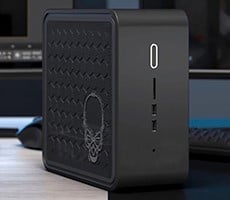Foxconn e-bot Small Form Factor PC
|
We continued our testing with another application from Futuremark, 3DMark03, and with a video encoding benchmark, Windows Media Encoder 9. In the WME9 test, we took a 416MB Digital Video file and encoded to a WMV9 format used for streaming video. Times were recorded in minutes and seconds, with lower times indicating better performance.

This benchmark was mostly a wash, as all three systems put up nearly identical times. What was most interesting to note, however, was that even though the Foxconn e-bot has consistently shown lower scores in the synthetic CPU and Memory benchmarks, it technically came in first in this "real-world" test.
|
It's not an actual game, but 3DMark03's built-in CPU test is a "gaming related" DirectX metric that's useful for comparing relative performance among similarly equipped systems. This test consists of two different 3D scenes that are generated with a software renderer, which is dependant on the host CPU's performance. This means that the calculations normally reserved for your 3D accelerator, are instead sent to the central processor. The number of frames generated per second in each test are used to determine the final score.

Using only the CPU benchmark as the basis for comparison, we've got the Epox eX5-320S back on top, followed by the Shuttle SB61G2 and finally the Foxconn e-bot. Not too surprising, since this is exactly the same order of systems that we saw with the PCMark04 CPU benchmark. The dropoff was much larger than we expected, and mulitple attempts at running 3DMark always produced the same results.






